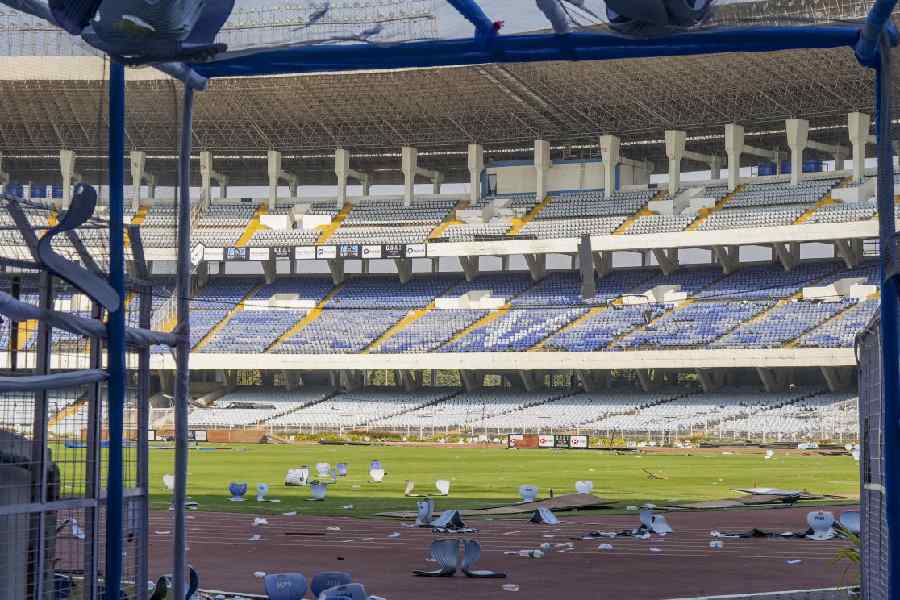Mumbai, Aug. 14: The Indian Navy was shaken by its most crippling peacetime blow when a submarine was ripped apart by blasts and sank at the dockyard here past midnight with all of its 18 crew members feared dead.
Operational-level officers at the Western Naval Command told The Telegraph that the explosion in the INS Sindhurakshak occurred when a detonator of a newly synergised Klub-S missile was being fitted.
The deaths have not yet been officially confirmed, because, as the navy chief, Admiral D.K. Joshi, said: “Miracles happen.”
The Russian-made and refurbished INS Sindhurakshak, a Kilo-class submarine, turned into an explosive, watery coffin after a fire in a compartment near its nose triggered blasts from warheads and deadly material meant for an enemy.
The three deafening blasts that ripped apart the INS Sindhurakshak could be heard over a 2km radius, including parts of south Mumbai. An enormous fireball rose from the submarine, leaping dozens of metres into the air.
“Submarine mishaps are usually catastrophic,” said Joshi.
Even as the submarine sank, firefighters took nearly three hours to douse the flames, some of which had touched the piers of the congested naval dockyard. The submarine plunged to the bottom of the bed, seven metres deep. Its conning tower was still at the surface. Hours later, rescuers stood on it and mapped their way into its interiors.
The INS Sindhurakshak, brought back into service only four months ago after a Rs 500-crore makeover, had flooded after the blasts blew a hole in the vessel.
With no submersible escape pod, as in other, more modern, submarines, the INS Sindhurakshak’s 18 sailors, including three officers, had no way to reach the surface, even if spared by the explosions. The only straws to clutch would have been emergency breathing devices and/or an air pocket, a part of the boat that could not be filled by water.
 |
| We hope for the best and are prepared for the worst - Admiral DK Joshi |
Two of the three officers and six of the 15 sailors were married.
“The wives of the missing officers are with the Naval Command, waiting for news about their missing husbands. Our Family Support Cell and Naval Wives’ Welfare Association are providing the family members with professional medical counselling,” Joshi told reporters, all but confirming the loss of his men.
“We hope for the best and are prepared for the worst,” he said.
Naval divers engaged in rescue since dawn prised open a hatch of the submarine around 4pm on Wednesday after a 12-hour ordeal, but found no survivors, said a source at the Western Naval Command. The impact of the explosions had so distorted the hull — the main body — that the hatches got jammed.
“She is inundated with muddy water and with evening setting in, it is difficult to bring out the bodies of our officers and sailors. But it is difficult to say at this stage how many we shall be able to retrieve as the blasts would have generated a temperature of the range of 5000°C-6000°C which would have vaporised those in its immediate vicinity,” said the navy source.
The navy has ordered a mandatory investigation by a board of inquiry. Joshi said that from the footage available, it appeared the explosions occurred in the armament compartment near the nose of the submarine as sailors were readying and arming the vessel.
“Debris of what seemed to be a missile and a booster were found at the dockyard,” he said.
The INS Sindhurakshak was due to leave for an operational deployment about 8 nautical miles from the Mumbai coast this morning.
While the homeport of all submarines is Vizag, the naval dockyard here is the hub of west coast operations — the “sword arm” of the navy with multiple layers of security.
Even within a dockyard, accessing a submarine with its own security rings is a challenging task for any kind of provocateur.
Joshi said though sabotage could not be ruled out, indicators so far did not point to that possibility.
All other submarines and ships were immediately pulled out of the area.
Despite being loaded with explosives and half-released torpedoes, the vessel is not a safety hazard, according to retired naval chief Admiral Vishnu Bhagwat.
BLAST & AFTER
What caused the fire or explosions?
Enough combustible material in the forward compartment, where the incident occurred, which also houses armaments and weapons. Oxygen, hydrogen, rocket fuel, warheads, sulphuric acid, mines — any, or several, could have caused it.
An inquiry will give report in four weeks
Could there have been a breach of safety drill?
Since 26/11, operational deployments of all warships have increased. This puts pressure on the upkeep of ageing fleet.
The navy has a long history of operating submarines. Safety drills involve both human effort and technical engineering. Theoretically, human or technical failure is possible
Could it have been sabotage?
Navy says indications available so far do not support such a theory
How will the unexploded ordnance be neutralised?
The submarine is already seven metres under water for more than 18 hours now. The muddy water that has poured into the submarine would have neutralised much of the ordnance. Unexploded ordnance can be neutralised in field firing ranges
Is it possible that some of the ordnance could still go off?
Theoretically, it is possible that if ordnance is in a compartment where water has not entered — like in an air pocket — it could explode.











